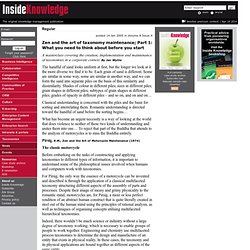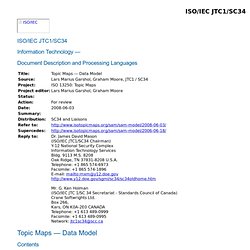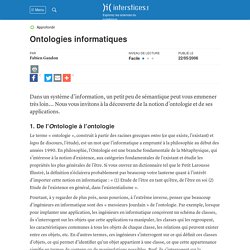

Media Annotations Working Grp W3C. Schémas XML = élément annotation. LinkedData: les ontologies c’est chouette. Protocol for Web Description Resources (POWDER): Primer. Abstract POWDER — the Protocol for Web Description Resources — provides a mechanism to describe and discover Web resources and helps the users to make a decision whether a given resource is of interest.

There are a variety of use cases: from providing a better means to describing Web resources and creating trustmarks to aiding content discovery, child protection and Semantic Web searches. There are two varieties of POWDER: a complex, semantically rich variety, called POWDER-S, and a much simpler version, just called POWDER, which is intended as the primary transport mechanism for Description Resources.
POWDER-S can be generated automatically from POWDER. Status of this Document This section describes the status of this document at the time of its publication. Publication as a Working Group Note does not imply endorsement by the W3C Membership. This is the third publication of the document as a Working Group Note by the POWDER Working Group. Zen and the art of taxonomy maintenance. Regular posted 14 Jan 2005 in Volume 8 Issue 4 A masterclass covering the creation, implementation and maintenance of taxonomies in a corporate context.

By Jan Wyllie The handful of sand looks uniform at first, but the longer we look at it the more diverse we find it to be. Each grain of sand is different. Classical understanding is concerned with the piles and the basis for sorting and interrelating them. What has become an urgent necessity is a way of looking at the world that does violence to neither of these two kinds of understanding and unites them into one… To reject that part of the Buddha that attends to the analysis of motorcycles is to miss the Buddha entirely. Pirsig, R.M., Zen and the Art of Motorcycle Maintenance (1974) The classic motorcycle Before embarking on the tasks of constructing and applying taxonomies to different types of information, it is important to understand some of the philosophical issues involved when humans and computers work with taxonomies. Ontology Matching. Topic Maps — Data Model. Information Technology — Document Description and Processing Languages Contents Foreword ISO (the International Organization for Standardization) and IEC (the International Electrotechnical Commission) form the specialized system for worldwide standardization.

National bodies that are members of ISO or IEC participate in the development of International Standards through technical committees established by the respective organization to deal with particular fields of technical activity. International Standards are drafted in accordance with the rules given in the ISO/IEC Directives, Part 2. ISO/IEC 13250-2 was prepared by Joint Technical Committee ISO/IEC JTC 1, Information Technology, Subcommittee SC 34, Document Description and Processing Languages. ISO/IEC 13250 consists of the following parts, under the general title Topic Maps: Topic Maps Conferences. Cartes topiques. Un article de Wikipédia, l'encyclopédie libre.

Pour les articles homonymes, voir Topic. Topic maps in content management. The rise of the ITMS Table of contents Abstract This paper shows how topic maps can address the limitations of traditional content management systems while building on their strengths.

The term ITMS (Integrated Topic Management System) is coined for a content management system based on topic maps, and the paper shows what is necessary to build such systems, as well as what benefits they bring. The use of the WebDAV protocol to layer topic maps over content stores is also considered, and an abstract topic map-to-content store protocol is sketched, which corresponds very closely to WebDAV. Une projection qui simplifie RDF. Michel Biezunski propose un nouveau modèle de données qui ressemble à une simplification du modèle de données RDF.

Eric van der Vlist, Dyomedea (vdv@dyomedea.com).jeudi 30 novembre 2006 Michel Biezunski, l'un des deux principaux concepteurs des Topic Maps, a réorganisé le site Web où il présente DPM (Data Projection Model), un modèle de données destiné à facilité l'intégration de données hétérogènes : "L'information est désordonnée et il est probable que cela sera toujours le cas. Plutôt que de prétendre qu'on va éliminer ce désordre, nous pouvons l'utiliser comme un fait, un point de départ. " Ontology. Artist. The TAO of Topic Maps.
Finding the Way in the Age of Infoglut Table of contents Abstract Topic maps are a new ISO standard for describing knowledge structures and associating them with information resources.

As such they constitute an enabling technology for knowledge management. Dubbed “the GPS of the information universe”, topic maps are also destined to provide powerful new ways of navigating large and interconnected corpora. While it is possible to represent immensely complex structures using topic maps, the basic concepts of the model — Topics, Associations, and Occurrences (TAO) — are easily grasped. )i( interstices - Ontologies informatiques. Dans un système d'information, un petit peu de sémantique peut vous emmener très loin...

Nous vous invitons à la découverte de la notion d'ontologie et de ses applications. 1. Classification, thésaurus, ontologies, folksonomies : comparaiso. L'Ontologie Est Surfaite. Accueil. Guide pour construire une ontologie – Christian Fauré. Voici un petit guide pour ceux qui veulent mettre en place une ontologie.

Ce n’est bien sûr pas la seule façon de procéder, mais c’est celle que je trouve la plus pertinente. Cette approche provient, entre autres, des travaux de Bruno Bachimont, Raphaël Troncy et Nathalie Aussenac-Gilles. 1. D’abord bien définir l’objectif de l’ontologie et comment son utilisation permettra d’atteindre ces objectifs. 2. 3. 4. 5. 6. 7. 8. 9. Méthodo ontologie.